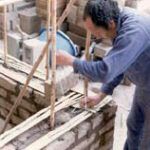Adobe mud blocks are one of the oldest and most widely used building materials. Use of these sun-dried blocks dates back to 8000 B.C.. The use of adobe is very common in some of the world’s most hazard-prone regions, such as Latin America, Africa, the Indian subcontinent and other parts of Asia, the Middle East and Southern Europe.
Around 30% to 50% of the world’s population (approximately 3 billion people) lives or works in earthen buildings. Approximately 50% of population in developing countries, including a majority of the rural population and at least 20% of the urban population, livein earthen dwellings. For example, in Peru, according to the 2007 Census, almost 40% of houses are made of earth. (That’s 2 million houses inhabited by around 9 million people.) In India, according to the 2001 Census, 30% of all buildings are made out of earth (this includes 73 million houses inhabited by almost 305 million people).
Adobe construction is mainly used in rural areas. Houses are typically one-story high, with wall heights of around 3.0 m and thicknesses ranging from 250 mm to 850 mm. In mountainous regions with steep hillsides such as the Andes, houses can be up to three stories high. In parts of the Middle East, earthen houses are often built one on top of the other, so that the roof of one house is used as the bottom floor of the house above. Adobe houses are found in the urban areas of most developing countries. In some countries, like Argentina and Chile and in some cities like San Salvador, adobe construction is banned by building codes because of its poor seismic performance.
Further introductory reading: “Adobe Construction”
(Marcial Blondet and Gladys Villa Garcia M.)
Download : ENGLISH [0.4MB]
Contents:
-Background
-Old and new techniques
-Seismic strengthening
The video above was developed as a part of the project “Development of communication materials and training methodology for the construction of seismic resistant and healthy adobe houses in seismic areas”, financed by the Earthquake Engineering Research Institute (EERI) and developed by a multidisciplinary team at the Catholic University of Peru (PUCP).

